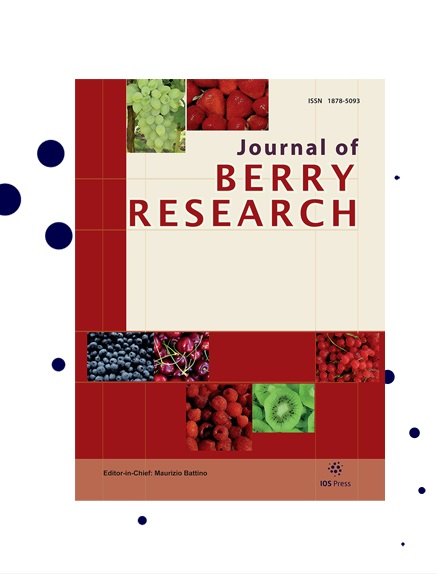全基因组鉴定和表达分析显示,肉桂醇脱氢酶基因与草莓果实硬度相关
IF 1.4
4区 农林科学
Q3 PLANT SCIENCES
引用次数: 5
摘要
背景:草莓果实易腐烂,收获后寿命短。肉桂醇脱氢酶(CAD)是木质素生物合成和植物细胞壁强化的关键酶。草莓CAD家族的系统表征是缺失的,它们在果实硬度的参与很大程度上是难以捉摸的。目的:研究草莓品种中CAD家族基因的全基因组鉴定及其与果实硬度的表达关系。方法:对商品草莓(Fragaria×ananassa)和林地草莓(F. vesca)的CADs进行基因组鉴定和分子表征。对三个品种果实硬度变化的CAD同源物进行qPCR分析,发现候选CAD成员与木质素含量和果实硬度呈正相关。结果:在夏威夷F.vesca var. Hawaii4和×ananassa F. ×ananassa cv的基因组中分别鉴定出14个和24个CAD位点。分别Camarosa。系统发育分析支持这个科分为三个纲。ⅰ类FvCAD在商品草莓中各有4个同源物,而ⅱ类和ⅲ类只有1个或2个同源物。除了FvCAD2和-6外,F. vesca和F. ×ananassa之间至少存在一对具有97%或以上氨基酸同源性的CADs。不同草莓种质间果肉硬度和木质素含量差异较大。果实木质素含量在大青期前有明显的动态变化,但果实硬度在果实发育过程中呈现相似的下降趋势。在F.×ananassa中检测到的8个基因中,FvCAD3和-12在果实发育过程中没有表现出偏向F. vesca的表达模式。ⅰ类FvCAD4的表达量与果实白期木质素含量变化呈显著正相关。FvCAD3、-8、-10、-11和-12 5类IIgenes的转录丰度与木质素含量和果实硬度呈正相关,其中FvCAD10和-11(先前发表的FaCAD)与三个品种间果实硬度的遗传变异呈极显著相关。结论:草莓ⅱ类CADs与果实硬度的遗传变异显著相关,为提高草莓的保质期提供了可能的选择。本文章由计算机程序翻译,如有差异,请以英文原文为准。
Genome-wide identification and expression analysis revealed cinnamyl alcohol dehydrogenase genes correlated with fruit-firmness in strawberry
BACKGROUND: Strawberry fruits are perishable with a short post-harvest life. Cinnamyl alcohol dehydrogenase (CAD) is the key enzyme for lignin biosynthesis strengthening plant cell wall. A systematic characterization of strawberry CAD family is absent and their involvement in fruit firmness is largely elusive. OBJECTIVE: Current work aims for a genome-wide identificationof CAD family and its expression correlation with fruit firmness in strawberry varieties. METHODS: A genome-scale identification and molecular characterization for CADs were performed in the commercial strawberry (Fragaria×ananassa) and woodland strawberry (F. vesca). qPCR analysis of CAD homoeologs in three cultivars varying with fruit firmness revealed candidate CAD members positively correlated with lignin content and fruit firmness. RESULTS: A total of 14 and 24 CAD loci were identified in the genomes of F.vesca var. Hawaii4 and F. ×ananassa cv. Camarosa, respectively.Phylogenetic analysis supported a division of this family into three classes. Class I FvCAD each has four homoeologs in commercial strawberry, while those of Class II and Class III have only one or two homoeologs. Except for FvCAD2 and -6, there exits at least one pair of CADs sharing ∼97% or above amino acid identity between F. vesca and F. ×ananassa.The flesh firmness and lignin content varied greatly among strawberry germplasm. Distinct dynamic changes in fruit lignin content were observed before the large green stage, but fruit firmness displayed a similar decrease profile during fruit development in three varieties. Of the eight genes detected in F.×ananassa, FvCAD3 and -12 did not display a F. vesca-biased expression pattern during fruit development.FvCAD4 of Class I was expressed at levels positively correlated with variation in fruit lignin content at white stage.Transcript abundance of five Class IIgenes including FvCAD3, -8, -10, -11, and -12 was positively correlated with lignin content and fruit firmness, with FvCAD10 and -11 (FaCAD in previous publication) reaching an extremely significant correlation with the genetic variation in fruit firmness across three varieties. CONCLUSION: Strawberry Class II CADs were significantly correlated with the genetic variation in fruit firmness, which might expand the potential choices for improving strawberry shelf life.
求助全文
通过发布文献求助,成功后即可免费获取论文全文。
去求助
来源期刊

Journal of Berry Research
Biochemistry, Genetics and Molecular Biology-Biochemistry
CiteScore
3.50
自引率
11.80%
发文量
21
期刊介绍:
The main objective of the Journal of Berry Research is to improve the knowledge about quality and production of berries to benefit health of the consumers and maintain profitable production using sustainable systems. The objective will be achieved by focusing on four main areas of research and development:
From genetics to variety evaluation
Nursery production systems and plant quality control
Plant physiology, biochemistry and molecular biology, as well as cultural management
Health for the consumer: components and factors affecting berries'' nutritional value
Specifically, the journal will cover berries (strawberry, raspberry, blackberry, blueberry, cranberry currants, etc.), as well as grapes and small soft fruit in general (e.g., kiwi fruit). It will publish research results covering all areas of plant breeding, including plant genetics, genomics, functional genomics, proteomics and metabolomics, plant physiology, plant pathology and plant development, as well as results dealing with the chemistry and biochemistry of bioactive compounds contained in such fruits and their possible role in human health. Contributions detailing possible pharmacological, medical or therapeutic use or dietary significance will be welcomed in addition to studies regarding biosafety issues of genetically modified plants.
 求助内容:
求助内容: 应助结果提醒方式:
应助结果提醒方式:


